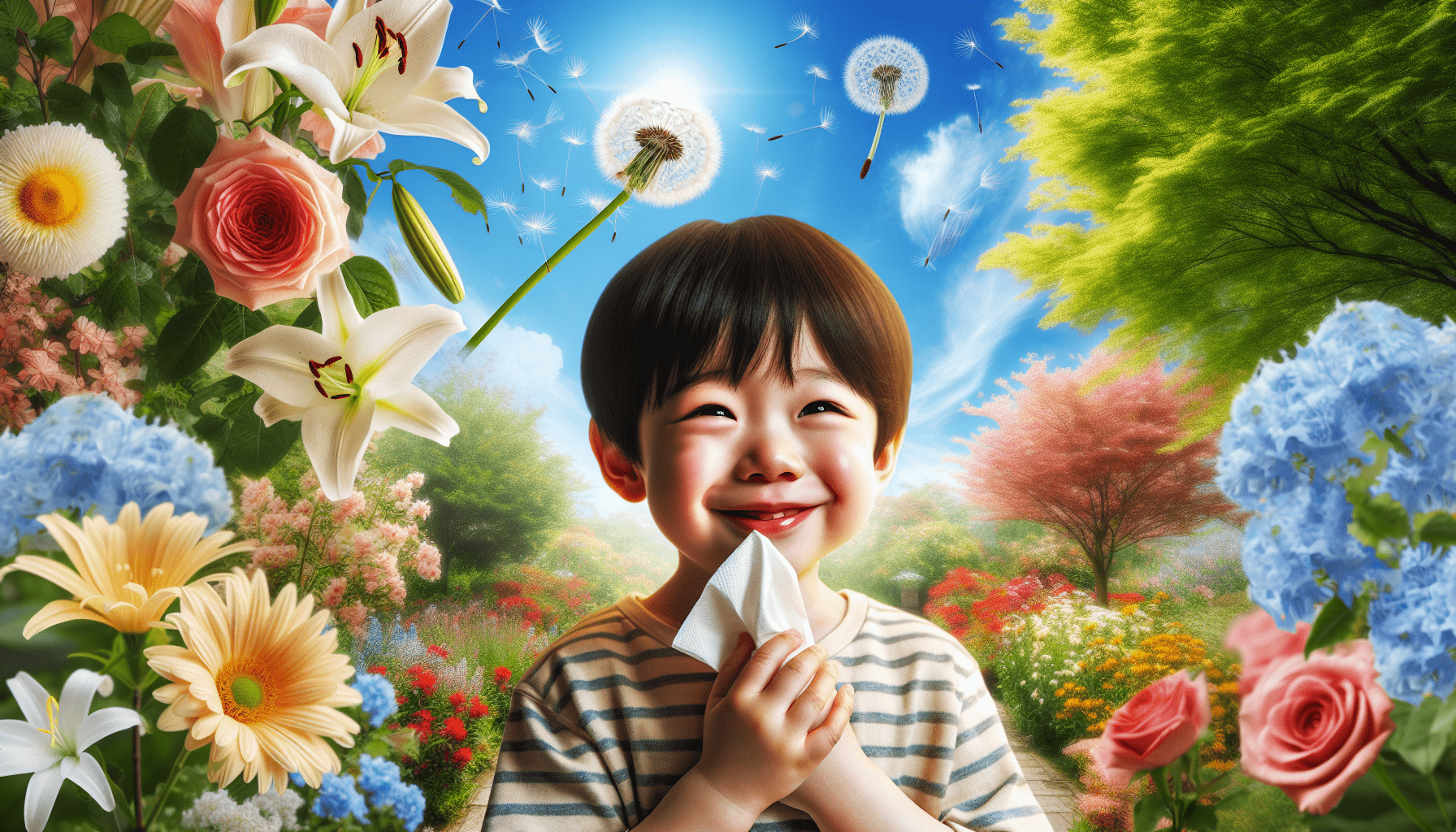As a caring parent, you want your child to enjoy life without the discomfort of allergies holding them back. In our article “Top Ways to Help Your Child Manage Their Allergies,” you’ll uncover practical tips and effective strategies to ease your child’s allergy symptoms. From creating an allergy-friendly home environment to identifying and avoiding triggers, you’ll find helpful advice to make breathing a sigh of relief easier for both you and your little one. With these insights, you’ll be well-equipped to support your child’s health and well-being every step of the way. Have you ever felt helpless watching your child battle allergies? It can be truly challenging to see them suffer through sneezes, coughs, itchy eyes, and the myriad other symptoms that accompany allergies. But the good news is, there are effective ways to manage and alleviate their discomfort. In this friendly guide, we’ll explore the top ways to help your child manage their allergies.

Understanding Allergies
To better help your child, it’s essential first to understand what allergies are and how they affect your little one. Allergies occur when the immune system overreacts to substances, known as allergens, which are generally harmless to most people.
Common Allergens
Allergens can vary widely, but some of the most common ones include:
| Allergen | Examples |
|---|---|
| Pollen | Trees, grasses, weeds |
| Food | Peanuts, shellfish, dairy |
| Indoor | Dust mites, pet dander, mold spores |
| Insect Stings | Bee stings, wasp stings |
| Medications | Penicillin, aspirin |
By identifying specific allergens, you can take appropriate steps to minimize your child’s exposure and manage symptoms effectively.
Recognizing Allergy Symptoms
Recognizing allergy symptoms helps in early diagnosis and effective treatment. Symptoms can vary depending on the allergen and mode of exposure.
Symptoms Based on Allergen
| Allergen | Symptoms | Examples |
|---|---|---|
| Pollen | Sneezing, itchy/watery eyes, runny nose, nasal congestion | Seasonal allergies |
| Food | Hives, stomach pain, vomiting, anaphylaxis | Nut allergies |
| Indoor | Persistent coughing, wheezing, itchy eyes, eczema flare-ups | Dust mites, pet dander |
| Insect Stings | Swelling, pain, redness, anaphylaxis | Bee stings |
| Medications | Rash, itching, shortness of breath, anaphylaxis | Penicillin allergy |
If you notice these symptoms, consult your pediatrician immediately for a proper diagnosis and treatment plan.
Preventive Measures
Preventing exposure to allergens is one of the initial steps in managing allergies. Here are some practical measures you can adopt.
Home Environment
Ensure your home environment minimizes potential allergens. Here are some tips:
- Dust and Vacuum Regularly: Keep your home dust-free using a vacuum with a HEPA filter.
- Wash Bedding in Hot Water: Helps eliminate dust mites and other allergens.
- Use Air Purifiers: Clean the air in your home with an air purifier, especially in your child’s room.
- Keep Windows Closed: Prevent pollen from entering during high pollen seasons.
- Regulate Humidity: Use dehumidifiers to keep indoor humidity between 30-50%, which can help reduce mold growth.
Outdoor Activities
Outdoor activities are crucial for your child’s physical and mental well-being, but exposure to allergens can be unavoidable.
- Monitor Pollen Count: Check daily pollen counts and plan outdoor activities when levels are low.
- Wearing Protective Gear: Use hats, sunglasses, and masks to reduce pollen contact.
- Showering After Play: Encourage bathing and changing clothes after outdoor activities to remove pollen.
Dietary Considerations
Food allergies can be particularly challenging, but careful meal planning and education can help manage this effectively.
Identifying Food Allergies
Identifying food allergens through observation and allergy testing is key. If your child has a known food allergy:
- Read Labels Carefully: Always check ingredient lists for allergens.
- Educate Your Child: Teach them about the foods they need to avoid.
- Substitute Ingredients: Learn to use safe alternatives in cooking and baking.
Healthy and Safe Alternatives
Providing your child with healthy and safe alternatives ensures they don’t miss out on essential nutrients.
| Food Allergen | Safe Alternatives |
|---|---|
| Dairy | Almond milk, soy milk, coconut milk |
| Peanuts | Sunflower seed butter, almond butter |
| Gluten (Wheat) | Gluten-free oats, rice, quinoa |
| Eggs | Apple sauce, flaxseeds, chia seeds |
Consult a nutritionist to design a balanced diet that meets your child’s nutritional needs without compromising safety.

Medical Intervention
Sometimes, despite your best efforts, medical intervention becomes necessary. Here’s what you need to know.
Medication
Several medications can help relieve allergy symptoms. Always consult your pediatrician before administering any medication.
- Antihistamines: Reduce sneezing, runny nose, and itching.
- Decongestants: Alleviate nasal congestion.
- Nasal Corticosteroids: Reduce inflammation in the nasal passages.
- EpiPens: For severe allergic reactions (anaphylaxis), make sure your child carries an EpiPen and knows how to use it.
Immunotherapy
If your child’s allergies are severe, immunotherapy, also known as allergy shots, might be recommended.
- Allergy Shots: Regular injections of the allergen in increasing amounts to help build tolerance.
- Sublingual Immunotherapy (SLIT): Allergen tablets placed under the tongue to build up immunity.
While these treatments require time, they can provide significant long-term relief.
Emotional Support
Managing allergies can be stressful for both you and your child. Providing emotional support is equally important.
Communication
Open communication with your child is key. Here’s how you can offer support:
- Listen: Allow them to express their feelings and concerns.
- Educate: Teach them about their condition in a way they can understand.
- Encourage: Build their confidence by showing them they can still enjoy life despite their allergies.
Social Support
Help your child by creating a support network:
- Inform Teachers and Caregivers: Make sure they are aware of your child’s allergies and know how to respond in emergencies.
- Join Support Groups: Connect with other families dealing with allergies for advice and support.
Creating Allergy Action Plans
Having an action plan can ensure quick and effective responses to allergic reactions.
Components of an Allergy Action Plan
| Component | Details |
|---|---|
| Emergency Contacts | List of phone numbers including doctors and emergency services |
| Symptoms Checklist | Recognize and document early symptoms |
| Medication List | Types, doses, and administration instructions |
| Action Steps | Step-by-step guide on what to do in case of an allergic reaction |
Make sure this plan is accessible to everyone responsible for your child’s care.
Staying Up to Date
Stay informed about the latest research and developments in allergy management.
Consult Health Professionals
Regular consultations with allergists and pediatricians can help keep your child’s allergy management plan up to date.
Continuous Education
- Read Reputable Sources: Follow medical journals and reputable health websites.
- Attend Workshops and Seminars: Participate in workshops to learn new strategies and meet other parents.
Conclusion
While managing your child’s allergies can seem daunting, with the right knowledge and tools, you can make a significant difference in their quality of life. From understanding allergens and recognizing symptoms to preventive measures and emotional support, every step you take brings relief and comfort to your child. Remember, you’re not alone in this journey. With patience, persistence, and a little help, you can effectively manage your child’s allergies and ensure they lead a happy, healthy life!
